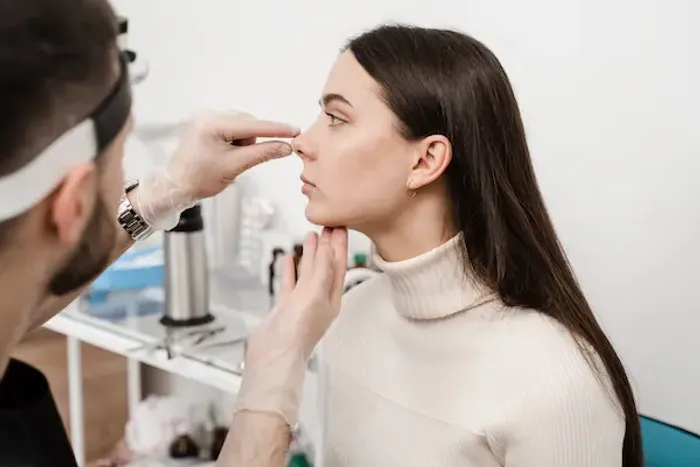Understanding Septoplasty
Septoplasty is a functional nasal surgery to correct a deviated septum and improve airflow. This complete guide covers symptoms, candidacy, what to expect before, during and after surgery, benefits, risks, alternatives, and how to prepare for the best results.


Introduction
Struggling to breathe through your nose can affect almost every part of life — from sleep quality to daily comfort. If you’re constantly congested, feeling “blocked” on one or both sides, or dependent on mouth breathing, you may have a deviated septum. Septoplasty is a straightforward surgery that corrects this by straightening the internal wall of the nose so air can flow freely.
Unlike rhinoplasty, which focuses on the external look of the nose, septoplasty focuses purely on function — helping you breathe better. In this guide, you’ll learn what the procedure involves, who might benefit, how to prepare, what happens on the day of surgery, expected recovery milestones, possible risks and how to reduce them, plus how it improves breathing and sleep. We’ll also cover alternatives, when it is medically necessary, cost considerations, and how to choose the right surgeon.
If you’ve tried nasal sprays, allergy treatment, or saline rinses and still feel persistently blocked, this clear and practical overview can help you decide whether septoplasty is the right next step toward easier breathing.
Consult a Top General Practitioner for Personalised Advice
What Is Septoplasty?
Septoplasty is a surgery that straightens the internal nasal wall (septum) to improve airflow.
The deviated septum explained
The nasal septum is the cartilage and bone wall dividing the nose into two air passages. When it leans or bends too far to one side, airflow becomes restricted. This can cause constant blockage, crusting, mouth breathing, or repeated sinus problems.
Septoplasty works by gently lifting the inner lining of the nose and reshaping or removing the parts of the septum
causing obstruction, while preserving the nose’s support structure.
Septoplasty vs rhinoplasty (form vs function)
Septoplasty improves breathing, not cosmetic appearance. Rhinoplasty reshapes the outside of the nose. Both can be combined into one surgery if someone wants both functional and cosmetic changes. Functional septoplasty is often covered by insurance, while cosmetic rhinoplasty is not.
When septoplasty is medically necessary
Doctors may recommend septoplasty when nasal obstruction affects daily life or sleep, contributes to frequent sinus infections, causes nosebleeds, or makes CPAP use difficult for sleep apnoea. Usually, this is considered after medical treatments such as intranasal steroid sprays and allergy control have been tried without success.
Who Needs Septoplasty? Symptoms, Diagnosis, and Candidacy
Septoplasty is recommended when a deviated septum causes persistent symptoms despite medical treatment.
Common symptoms
Signs that a deviated septum may be the problem include:
- One-sided blockage or noisy breathing during sleep
- Repeated sinus infections
- Nosebleeds from dryness or irritation
- Facial pressure
- Reduced smell or taste when airflow is limited
Evaluation and diagnosis
Doctors usually start with a physical examination and may perform a nasal endoscopy — a thin camera that allows them to view the septum and surrounding tissues clearly. A CT scan may be used if chronic sinus issues are suspected.
A short questionnaire called the NOSE score helps measure how severe nasal obstruction feels before and after treatment.
Clinicians also look for allergies or turbinate swelling, which can make symptoms worse.
When medical therapy isn’t enough
Typical first-line treatments include:
- Saline rinses
- Intranasal steroid sprays
- Allergy medicines
If symptoms continue for several weeks despite treatment, septoplasty may be needed.
If symptoms persist beyond two weeks, even after correct early self-care and medication, you can consult a doctor
online with Apollo24|7 for guidance and a referral to an ENT specialist.
When to seek help
You should seek a medical review if you have:
- Persistent one-sided nasal obstruction
- Recurrent sinus infections
- Nasal whistling or frequent bleeding
Video consultations are helpful for initial review. Nasal endoscopy is done during an in-person visit for confirmation.
Urgent in-person assessment is needed for:
- Severe nosebleeds
- High fever
- Facial swelling
Preparing for Septoplasty: Tests, Timing, and Planning
Pre-surgical planning focuses on safety, healing, and a smooth recovery.
Pre-operative consultation
Your surgeon will discuss:
- Medical history and nasal examination findings
- Anaesthesia (usually general anaesthesia is used)
- Whether endoscopic septoplasty is suitable for you
You should provide a list of all medications and supplements. Some medicines — including blood thinners and certain herbal products — may be paused temporarily, but only under medical guidance.
Tests and clearance
Pre-operative blood tests may be required to ensure safe surgery. If you have asthma, sleep apnoea, or heart conditions, specialist clearance may be advised.
Apollo24|7 provides convenient home sample collection for common tests if recommended by your clinician.
Planning for recovery time
Septoplasty is usually performed as a day-care procedure, with patients going home the same day.
Recovery time:
- Desk jobs: 5–7 days
- Physically demanding work: 2–3 weeks
Avoid long flights for 1–2 weeks to reduce sinus pressure changes. If you use CPAP for sleep apnoea, your care team will advise when to resume using the device.
The Procedure: Techniques, Anaesthesia, and What Happens
Septoplasty focuses on improving nasal airflow through internal reshaping.
Endoscopic vs traditional approach
Endoscopic septoplasty uses a small camera inside the nose for greater precision and less tissue disruption, while
traditional approaches rely on direct visualization. Both are effective depending on individual anatomy and surgeon
experience.
Turbinate reduction and add-on procedures
If the turbinates — the structures that warm and filter air — are enlarged, they can also be reduced during septoplasty.
In people with chronic sinusitis, sinus surgery may be performed at the same time to improve overall breathing and
sinus drainage.
Splints or packing?
Surgeons today often avoid large packing and instead use soft splints or internal stitches to support the septum. Some
materials dissolve on their own. The method used can influence early comfort during recovery, so it’s worth discussing
in advance.
Duration and same-day process
Surgery typically takes 45–90 minutes. After a short stay in recovery for monitoring, you will receive instructions for
pain relief, saline sprays, and activity limitations before going home the same day.
Benefits and Evidence: Breathing, Sleep, and Quality of Life
Most people experience significantly better nasal breathing after swelling settles.
Symptom relief and better airflow
Patients usually notice improved breathing and reduced congestion once swelling decreases. Improvements are often
measured through a large drop in NOSE scores, reflecting enhanced comfort and easier airflow.
Better breathing also supports:
- More energy during the day
- Better exercise tolerance
Sleep benefits and CPAP tolerance
Septoplasty can reduce snoring when nasal blockage is a major contributor, but it is not a cure for obstructive sleep apnoea. For those using CPAP, straighter nasal passages often make the device more comfortable and effective by reducing pressure needs.
What septoplasty does not do
Septoplasty does not alter how the nose looks from the outside. If someone wants both breathing improvements and
cosmetic changes, combined septorhinoplasty may be an option.
Risks and How to Reduce Them
Like any procedure, septoplasty has risks, but serious complications are uncommon.
Common side effects
Short-term side effects often include:
- Congestion
- Mild bleeding
- A feeling of pressure inside the nose
Bruising around the eyes is rare unless combined with rhinoplasty.
Less common risks
These may include:
- Infection
- Septal haematoma (blood under the lining)
- Septal perforation (a small internal hole)
- Temporary numbness of the upper teeth or lip
- Very rarely, a change in nasal support or shape
Revision surgery may be needed if obstruction returns or symptoms persist.
When to seek urgent care
Call your surgeon urgently if you notice:
- Heavy bleeding that doesn’t stop
- Fever above 38°C
- Worsening pain or swelling
- Vision changes
- Foul-smelling discharge
If symptoms do not improve with early supportive care, you can consult a doctor on Apollo24|7 for immediate
guidance and referral if needed.
Reducing your risk
You can help ensure a smooth recovery by:
- Following medication instructions
- Avoiding smoking
- Using saline sprays as advised
- Not blowing your nose early after surgery
- Attending follow-up visits for splint removal or checks
Recovery Roadmap: Day-by-Day Guide and Practical Tips
Healing is gradual — breathing keeps improving as swelling settles.
Days 0–3: managing swelling and comfort
Expect more pressure than sharp pain. Pain relief is usually effective, and sleeping with your head elevated can ease swelling. Avoid hot showers and spicy meals initially as they can trigger bleeding. A small amount of pink-tinged discharge is normal. Use a gauze pad under your nostrils if needed.
Week 1–2: return to routine
Many people return to desk work after about a week. Light walking is encouraged. Avoid heavy exercise and bending
forward. If splints were placed, they are usually removed between 5–10 days, often leading to more noticeable airflow
improvement.
Weeks 3–6: final healing phase
Internal swelling continues to settle. Saline rinses remain important. Gentle return to exercise is usually allowed, but
contact sports should wait until cleared — commonly after 4–6 weeks — to protect the healing septum.
Home preparation and lifestyle tips
Helpful ideas include:
- Use extra pillows or a bedside humidifier
- Stock up on saline rinses and soft, easy-to-eat foods
- Avoid smoking and limit alcohol
Setting reminders for nasal care and gentle walks helps recovery progress smoothly.
If questions arise at any stage, Apollo24|7 provides quick access to clinicians for expert guidance.
Alternatives, Add-On Procedures, and Choosing a Surgeon
Some nasal blockage improves with medical therapy, but structural deviation usually needs surgery.
Non-surgical options
People often try:
- Saline rinses
- Nasal steroid sprays
- Allergy therapies
- Occasional decongestant use
- External nasal strips at night
These can help but may only provide temporary relief if the structural deviation is the main issue.
Combining septoplasty with other procedures
Surgeons often combine septoplasty with turbinate reduction to achieve better airflow. For those with chronic sinus
infections and CT-confirmed disease, sinus surgery may also be done. If cosmetic changes are wanted, septorhinoplasty
avoids the need for two separate recoveries.
Cost, insurance, and choosing a surgeon
Costs vary based on the hospital, anaesthesia type, and additional procedures. Functional septoplasty is usually covered
when medically necessary; cosmetic elements are typically self-funded.
Questions to ask a surgeon:
- Do you perform endoscopic septoplasty?
- Will I need splints or packing?
- What is your revision rate?
- How many septoplasties do you perform regularly?
Choosing a board-certified ENT or facial plastic surgeon with strong experience improves the likelihood of a smooth procedure and optimal results.
Conclusion
Septoplasty is a reliable and effective way to improve nasal breathing when a deviated septum causes persistent
obstruction. By straightening the internal septum, the surgery opens the airways, which can lead to more comfortable breathing, better sleep, and an overall boost in quality of life. It isn’t designed to change the outer nose shape, but cosmetic and functional improvements can be combined if desired.
Risks exist with any surgery, but complications are uncommon when you follow pre- and post-operative guidance and choose an experienced surgeon. If symptoms continue even after using nasal sprays, saline rinses, and allergy management, consider a detailed ENT evaluation. If symptoms last beyond two weeks or you’re unsure what to do next, a doctor on Apollo 24|7 can help you with personalised advice and a referral for a thorough nasal assessment.
Easier breathing is achievable — and septoplasty may be the step that gets you there.
Consult a Top General Practitioner for Personalised Advice
Consult a Top General Practitioner for Personalised Advice

Dr. Anand Ravi
General Physician
2 Years • MBBS
Bengaluru
PRESTIGE SHANTHINIKETAN - SOCIETY CLINIC, Bengaluru

Dr Syed Mateen Pasha
General Physician
2 Years • MBBS
Bengaluru
PRESTIGE SHANTHINIKETAN - SOCIETY CLINIC, Bengaluru

Dr. Syed Ismail Ali
General Practitioner
7 Years • MBBS
Hyderabad
Apollo 24|7 Clinic, Hyderabad

Dr. Johnson. S
General Practitioner
7 Years • MBBS MD(Preventive and social Medicine)
Pune
Apollo Clinic, Nigdi, Pune

Dr. Madhuri Sai Sreepada
General Practitioner
9 Years • MBBS
Hyderabad
BRIGHT SMILES MEDICARE & DENTAL CARE, Hyderabad
Consult a Top General Practitioner for Personalised Advice

Dr. Anand Ravi
General Physician
2 Years • MBBS
Bengaluru
PRESTIGE SHANTHINIKETAN - SOCIETY CLINIC, Bengaluru

Dr Syed Mateen Pasha
General Physician
2 Years • MBBS
Bengaluru
PRESTIGE SHANTHINIKETAN - SOCIETY CLINIC, Bengaluru

Dr. Syed Ismail Ali
General Practitioner
7 Years • MBBS
Hyderabad
Apollo 24|7 Clinic, Hyderabad

Dr. Johnson. S
General Practitioner
7 Years • MBBS MD(Preventive and social Medicine)
Pune
Apollo Clinic, Nigdi, Pune

Dr. Madhuri Sai Sreepada
General Practitioner
9 Years • MBBS
Hyderabad
BRIGHT SMILES MEDICARE & DENTAL CARE, Hyderabad
More articles from Deviated septum
Frequently Asked Questions
1) Does septoplasty fix snoring?
Septoplasty can reduce snoring if nasal blockage is the main reason, but it does not cure obstructive sleep apnoea. If snoring continues after recovery, a sleep study or CPAP use may still be necessary.
2) How long is the septoplasty recovery time?
Most people feel significantly better within 1–2 weeks and return to desk work within 5–7 days. Full internal healing takes around 4–6 weeks, and strenuous activities should wait until cleared.
3) Is septoplasty painful?
Pain is usually mild to moderate and controlled with medication. The sensation is often described as nasal pressure and stuffiness more than sharp pain.
4) Will septoplasty change the shape of my nose?
No — the procedure targets the internal septum only. Cosmetic changes require additional techniques that can be combined if requested.
5) What are the main risks?
Common risks are congestion and mild bleeding. Rarer risks include infection, perforation, or temporary numbness in the upper teeth or lip. Heavy bleeding, fever, or severe pain should be promptly assessed. For any concerns, you can consult a doctor through Apollo24|7 for quick guidance.
